21.1 Protectionism An Indirect Subsidy from Consumers to Producers
1/12
There's no tags or description
Looks like no tags are added yet.
Name | Mastery | Learn | Test | Matching | Spaced |
|---|
No study sessions yet.
13 Terms
Nontariff barriers are
Select the correct answer below:
numerical limitations on the quantity of products that a country can import
rules, regulations, inspections, and paperwork which make it more costly or difficult to import products
taxes levied on the value of imported goods
all of the above
rules, regulations, inspections, and paperwork which make it more costly or difficult to import products
Nontariff barriers are all the other ways that a nation can draw up rules, regulations, inspections, and paperwork to make it more costly or difficult to import products. A rule requiring certain safety standards can limit imports just as effectively as high tariffs or low import quotas, for instance.
The graph below shows domestic supply and demand for luxury cars in the U.S. Suppose that at any price, foreign suppliers of luxury cars will supply 50 cars. Note that before trade occurs, the original equilibrium is at (40,$50), which is the intersection of Demand and Domestic Supply.
The "Domestic Supply + Imports" curve is misplaced. Re-position the curve to reflect the 50 cars that will be imported.
(90,$50)
If foreign countries will supply 50 luxury cars at any price level, the supply plus imports curve should be located 50 units to the right of the supply curve (along the demand curve) in the market for luxury cars. The increase in supply due to foreign suppliers will reduce the market price.
When there is free trade, the equilibrium is at the intersection of "Demand" & "Domestic Supply + Imports." When there is no trade, the equilibrium is at the intersection of "Demand" & "Domestic Supply."
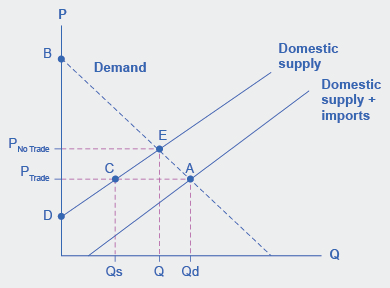
At a price of $10 the market is at point E. However, at a price of $8 quantity demanded exceeds quantity supplied. What is the price with trade?
$8
After trade, the domestic price of a good falls, resulting in the necessity to import the product from abroad. This is because the domestic quantity demanded is greater than the domestic quantity supplied, creating a shortage in the domestic market. The only way this could happen is if price fell to below its domestic equilibrium price.
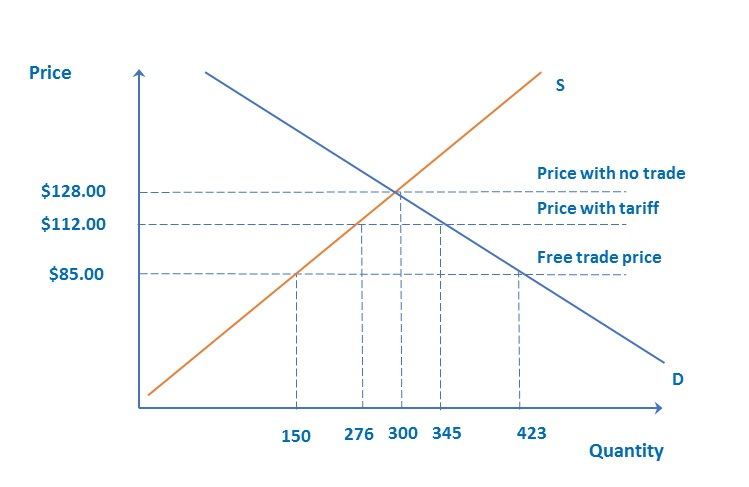
The below graph shows the domestic motor oil market in the U.S (in millions of liters). Based on the information given, how many liters of motor oil does the U.S. import given that the US government has imposed a tariff on the import of motor oil?
69 million liters
Under a tariff, the U.S. will import motor oil and the price of imports will be $112. The volume of imports is found by subtracting the quantity of oil supplied domestically, 276 million liters from the quantity demanded by domestic consumers, 345 million liters. The imports are 69 million liters of motor oil.
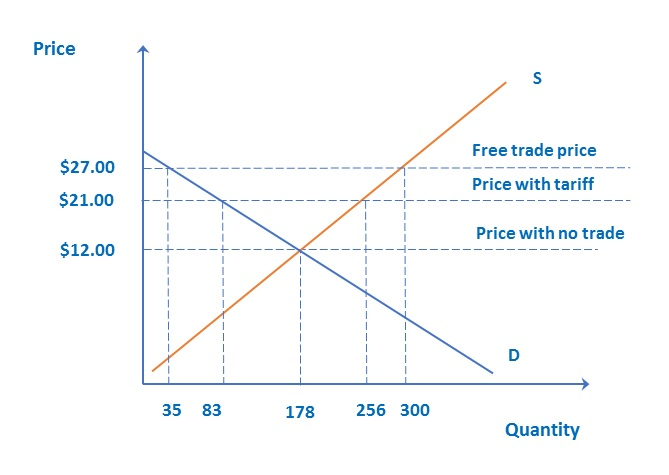
Use the graph below to answer the following question:
Assume that the below graph illustrates the cars market in the U.S. and that currently, the industry operates under an import tariff. How many more cars will the US produce if an environment of free trade exists?
44
At the price with tariff ($21.00) the Quantity Supplied is 256. If no restrictions existed on trade (free trade) the Quantity Supplied would be 300. That is an increase of 44 cars produced.
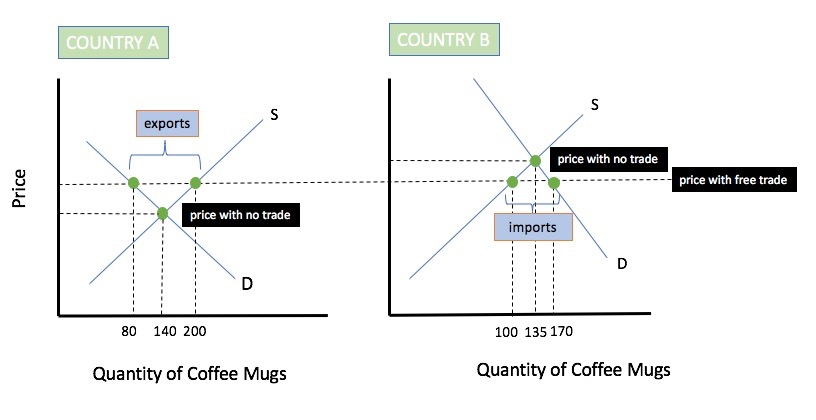
At a world price with free trade, Country B has a quantity demanded of 170 while it only has a domestic quantity supplied of 100. This implies that Country B would likely import __________ coffee mugs from Country A.
70
A shortage is defined as the difference between quantity demand and quantity supplied. In this case, 170−100=70. Therefore, Country B has a shortage of 70 coffee mugs and would likely import 70 coffee mugs from Country A.
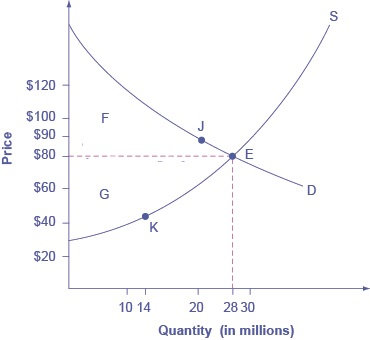
In the graph above, which letter represents the gains to trade consumers receive?
F
A tariff on the import of sugar will hurt ______________.
(Note: There are two correct answers.)
Select all that apply:
domestic producers of sugar
domestic consumers of sugar
domestic producers of goods that use sugar as an input to production
foreign buyers of sugar
domestic consumers of sugar
domestic producers of goods that use sugar as an input to production
For consumers in a country with the protected good, in this case, U.S. sugar consumers, restricting imports is clearly negative. They end up buying a lower quantity of the good and paying a higher price for what they do buy, compared to the equilibrium price and quantity with the trade. Both sugar end buyers and companies that use sugar in the production of other goods will be negatively impacted.
The graph below shows domestic supply and demand for wood in the US. Suppose that at any price, foreign suppliers of wood will supply 10 million units.
The "Domestic Supply + Imports" curve is misplaced. Re-position the curve to reflect the 10 million units that will be imported. (Note that quantity is expressed in millions on the graph.)
(50,$50)
If foreign countries will supply 10 million units of wood at any price level, the supply plus imports curve should be located 10 million units to the right of the supply curve in the market for wood. The increase in supply due to foreign suppliers will reduce the market price.
Which of the following are examples of nontariff barriers?
Select all that apply:
a 15% tax on the value of imported foreign cars
a requirement for imported toys to pass a safety inspection before they can be sold in the U.S.
a limit of 500 boats per year that can be imported into the U.S.
A requirement on imported car emissions to comply to U.S. air quality regulations before they can be sold in the U.S.
a requirement for imported toys to pass a safety inspection before they can be sold in the U.S.
A requirement on imported car emissions to comply to U.S. air quality regulations before they can be sold in the U.S.
Nontariff barriers are all the other ways that a nation can draw up rules, regulations, inspections, and paperwork to make it more costly or difficult to import products. A rule requiring certain safety standards can limit imports just as effectively as high tariffs or low import quotas, for instance. Requirements on products to pass safety inspections or comply with domestic rules are ways in which imports are often effectively restricted.
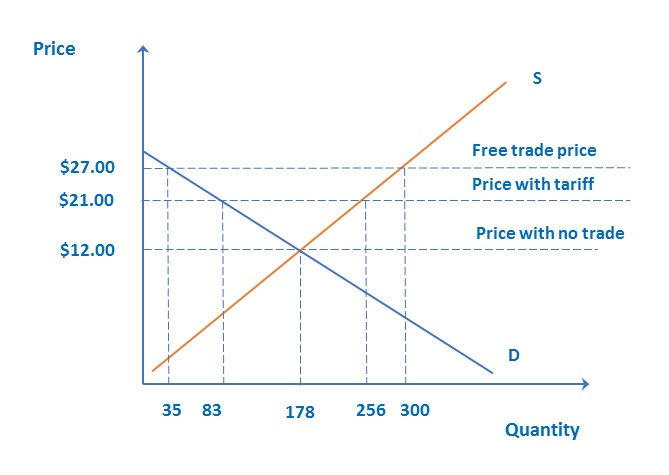
The below graph shows the domestic sugar market in Mexico (expressed in millions of tons). Based on the information given, how many tons of sugar does Mexico export provided there is no protectionism and the domestic demand is 35 tons.
265 million tons
Under free trade, Mexico will export sugar and the price of exports will be $27.00. The volume of exports is found by subtracting the quantity of sugar demanded domestically, 35 tons, from the quantity supplied by Mexico sugar suppliers, 300 tons, at the free trade price of $27.00. The exports are 265 million tons of sugar.
Eliminating a tariff on imported cars will hurt
Select the correct answer below:
domestic buyers of cars
domestic producers of cars
foreign producers of cars
all of the above
domestic producers of cars
For protected producers, such as U.S. car manufacturers, reducing the restriction on car imports will have negative effects. They will face higher competition from car producers from abroad and will have to lower car prices to stay competitive.
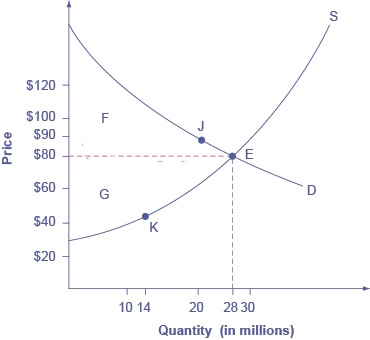
What letter represents the gains from trade which producers receive in a market?
G
The area bounded by equilibrium price and supply is known as produce surplus which are the gains from trade producers receive in a market.